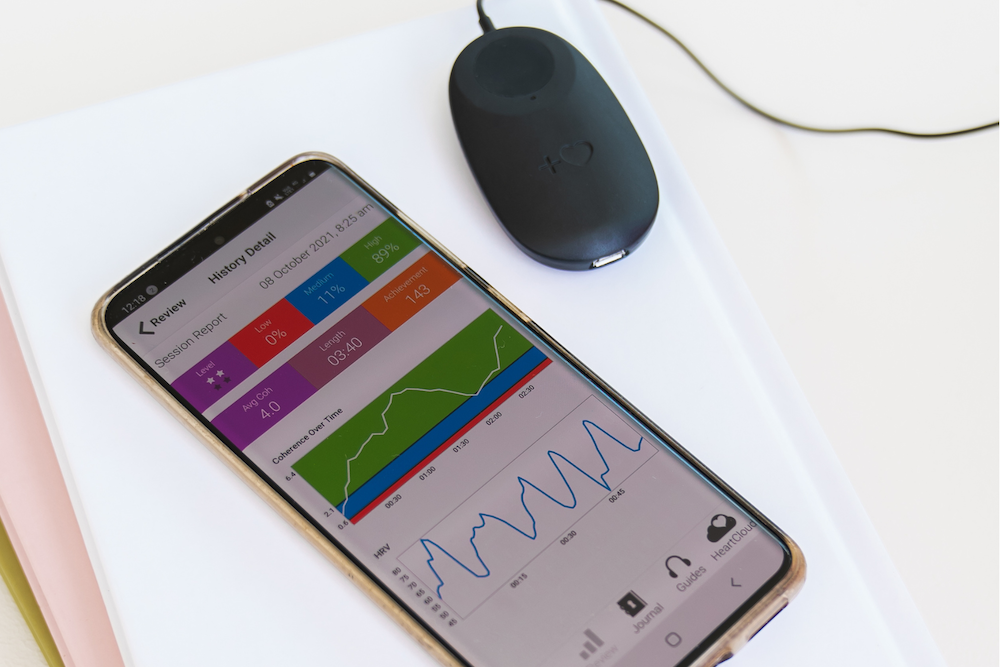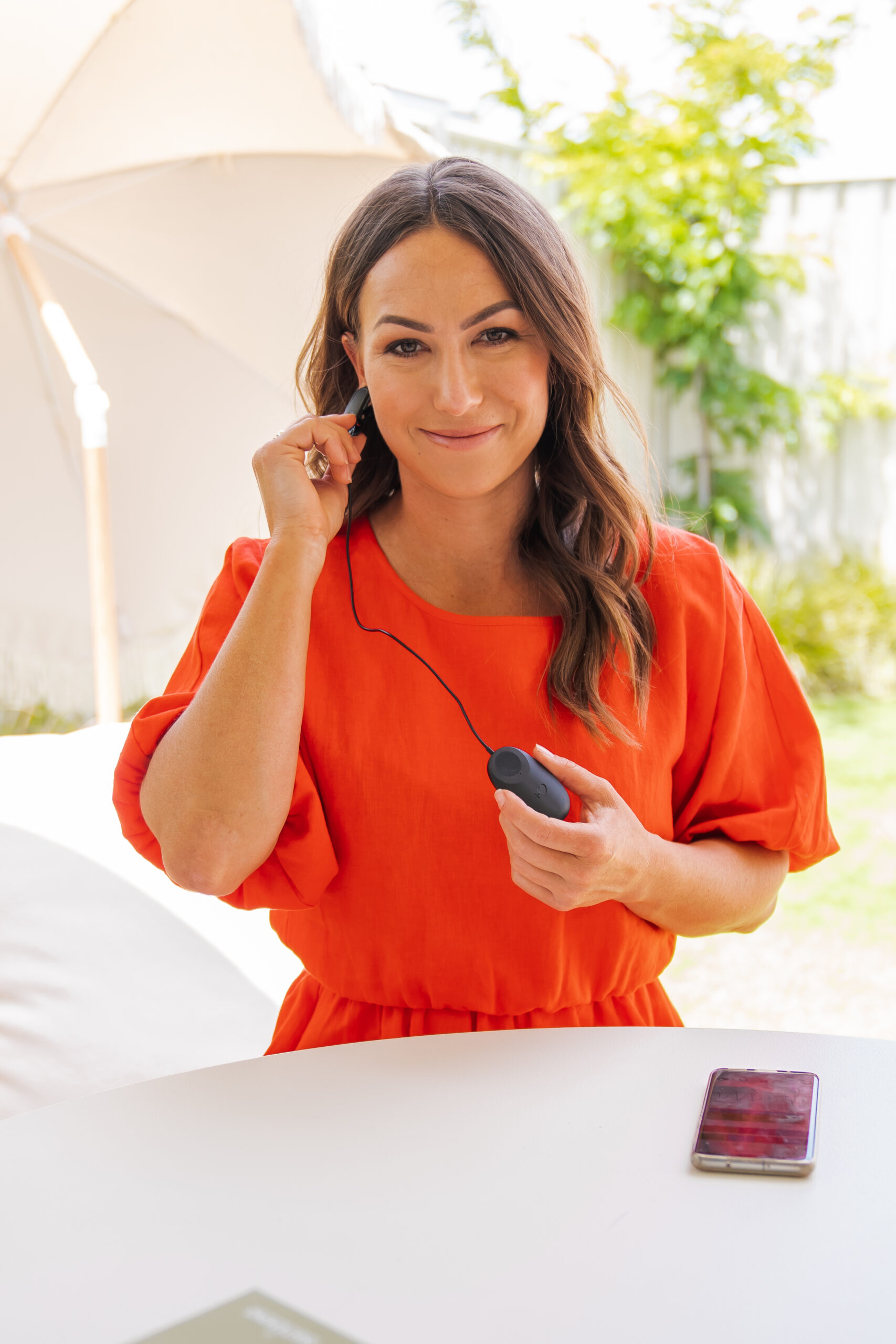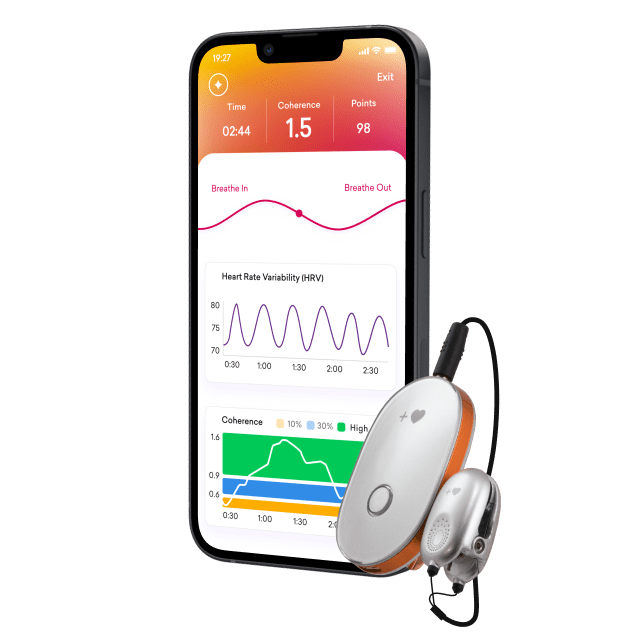July for me was A LOT – mentally, emotionally, spiritually. One of those months that tests every tool in your emotional resilience toolkit. But in navigating the chaos, I’ve found myself relying more than ever on a practice I picked up years ago that quite literally changed my life.
Today, I want to introduce you to research from the HeartMath Institute that transformed not just my understanding of stress, but my entire relationship with my nervous system. And I want to give you some free resources and discounts to explore Heartmath tools if this speaks to you – because honestly, it has been a game changer for me!
The brain seems to be a hot topic in personal development right now, with every influencer and expert talking about the power of neuroscience, mindset, and neuroplasticity – and hey, I’m guilty of driving these conversations too. But there is more to the story than most experts share.
What you’re about to read might challenge everything you think you know about managing your thoughts, feelings, and emotional state.
Did you know that your heart sends more signals to your brain than your brain sends to your heart? Or that each pump of your heart generates a magentic frequency that carries information outside of your body to influence the environment around you — I’m not kidding!
For years, we’ve been taught that the heart is simply a pump that responds to the brain’s commands. But research over the last 40 years tells us that your heart is actually influencing your brain’s function; affecting everything from your emotional processing to your ability to think clearly, remember information, and make effective decisions.
This explains why, when you’re stressed or anxious you literally cannot think straight. Your heart’s erratic rhythm pattern is sending chaotic signals to your brain, inhibiting your higher cognitive functions.
These heart signals impact:
- Emotional processing
- Attention and perception
- Memory formation
- Problem-solving abilities
- Decision-making capacity
In other words, your heart is literally shaping how you think, feel, and perform every single day.
The Emotional-Heart Rhythm Connection
Over decades, the HeartMath Institute has been researching the connection between the heart, brain, and emotions. After studying thousands of individuals the evidence landed on something pretty amazing: emotions create distinct heart rhythm patterns and directly influence heart rate variability (HRV).
During stress, anger, or anxiety: Heart rhythms become erratic and jagged (incoherent). The sympathetic and parasympathetic systems fight each other. It’s like driving with one foot on the gas and one on the brake, sending chaotic signals to the brain, inhibiting clear thinking.
During appreciation, joy, or compassion: Heart rhythms become smooth, sine-wave patterns (coherent). Both nervous system branches synchronize, multiple body systems entrain to the heart’s rhythm, and the brain receives organized signals that enhance cognitive function.
This isn’t “woo woo” – it’s measurable, reproducible psychophysiological change backed by decades of peer-reviewed research.

HeartMath Changed My Mind (And My Life)
Back in 2018, I got my hands on my first HeartMath Inner Balance device. At the time, I was still recovering from years of burnout and living in a body that didn’t know how to switch off. I couldn’t sit still, pivoting from one project to the next.
I sang praise to the benefits of meditation, but could I sit and meditate for more than a minute? NOPE. My mind would start stacking all the things I needed to do, and before I knew it I’d be on my feet and out the door — Sound familiar?
This was “normal”. Until I invested in an Inner Balance device.
Instead of fighting my busy mind, it gave me something to focus on – a breathing pacer and real-time heart rhythm biofeedback. When my mind wandered, I’d immediately see those smooth coherent waves turn chaotic again.
I could literally watch my nervous system shift from stress to optimal function by focusing on heart-felt emotions like appreciation or compassion. It was measurable proof that I had the power to change my physiology in real-time.
This discovery led me to train as a HeartMath practitioner and integrate these techniques into my programs and support women worldwide transform their relationship with stress.

Coherence vs. Relaxation: Understanding the Difference
Here’s something most people get wrong – coherence isn’t relaxation.
Relaxation is a low-energy state with reduced autonomic activity and disengagement from cognitive processes.
Coherence is an active, energized state where you’re calm but alert, peaceful but productive.
Over 500 peer-reviewed studies have shown that when you achieve psychophysiological coherence your entire body shifts into optimal function.
This isn’t relaxation or stress management. It’s a tool that has proven effective in navigating change, health crisis, addiction, peak performance, and daily wellbeing.
Coherence As a Tool – In the Real World
Last month, my mum had a stroke, and I was reminded of just how powerful this tool is.
Here’s a woman who has always lived an active lifestyle, ate organic, juiced daily, has her health supplements lined up along the counter (she puts me to shame, honestly).
But despite all this, stress and lifestyle choices led to her first heart attack at 38, followed by three more cardiac events in later years, and now a stroke — which MRI reveals isn’t her first.
The most challenging part of supporting her recovery has been helping her overcome smoking addiction and navigating those automatic triggers like phone calls or stressful moments. The Inner Balance device is perfect for mum right now.
If you’re a smoker, think about what your body is quietly asking for…
When do you reach for a smoke? When stressed.
What do you need to do when you’re stressed? Take a deep breath.
What do you do when your smoke? Take a deep breath
Mum can clip the device to her ear and watch in real-time as her heart rhythm shifts from chaotic to coherent. Using the breath pacer, she can take those deep inhalations (minus the nicotine and chemicals) and regulate herself within minutes.

Coherence in Times of Stress or Transition
Heart coherence meditations — the simple act of bringing your breath to a controlled rhythm whilst holding positive emotion in your heart — is what got me through the emotional whiplash that was July; a relationship separation, finding a place to live, then fleeting to the other side of the country for a family medical crisis – which all hit me in the space of 3 weeks!
This practice:
- Kept me present to work through problems at hand
- Helped me avoid reactive or fear-based decisions
- Kept me from ruminating on mental stories
- Allowed me to process emotions rather than carry – or bury them
These tools and this practice aren’t just for times of stress, transition, or health crisis. I use coherence for every day performance. It has become a practice that comes naturally too me now, but it was just that – a practice.
Now:
- I recommend it to friends who “can’t meditate.”
- I use it before speaking on stage.
- I teach it to clients and my teams so they can shift state before difficult conversations, big decisions, or moments they need to show up at their best.
Getting Started with Heart-Brain Optimization
The beauty of this science is its accessibility. You don’t need years of training or perfect conditions. You need:
- Intention. Generate positive emotions intentionally
- Practice. Yes, happiness, clarity, gratitude, and peace are a practice
- Consistency. Keep showing up for the practice until it becomes second nature.
(Four is optional)
- Tools. For self-coaching and real-time biofeedback get yourself an Inner Balance device.
With regular practice, most people can learn to shift into coherence by directly activating positive emotions, creating sustainable improvements in both HRV and overall well-being.
The difference between mindset advice of “just think positive“, and cultivating genuine heart-felt emotion to regulate your state, is that you are building physiological resilience not emotionally gaslighting yourself – I write more on that here.

The Ripple Effect: Beyond Personal Transformation
Here’s perhaps the most fascinating discovery: the heart’s magnetic field extends 3 feet beyond your body, carrying information that affects other people, even pets. When you achieve coherence, you’re literally radiating a different energy signature into your environment.
This means coherence training isn’t just personal development – it’s collective transformation. When you shift your heart rhythm patterns, you’re influencing everyone around you.
The Future of Human Potential
What excites me most about HeartMath research is how it’s fundamentally changing our understanding of human potential. We’re not victims of our stress responses or slaves to our circumstances. We have measurable, scientific tools to optimize our heart-brain communication and transform our entire physiological state.
It’s self-actualization, performance optimization, emotional intelligence training, and neuroplasticity in action.
When you understand that you have the power to change your heart rhythm patterns, and through that, your entire state of being – everything changes. Not just for you, but for everyone whose life you touch.
Start The Journey
Ready to check out HeartMath for yourself?
Whether you’re looking for some free courses, certification training, or biofeedback tech to improve your fitness, health, and overall wellbeing then checkout heartmath.com.
If you decide to give the Inner Balance a try, use code: JEMAINE at the checkout for 10% off.

Just an FYI – When you buy through the links on this page I may earn an affiliate commission. Rest assured, any product or brand I put my name behind is something I’ve researched, tried, tested, and loved. HeartMath is 100% one of them.
Frequently Asked Questions
Coherence training is a scientifically-backed technique that teaches you to regulate your heart rate variability (HRV) through positive emotions and breathing awareness. HeartMath techniques involve focusing on the heart area, breathing deeply and slowly, and shifting to a positive emotion. This helps to establish a smoother and more balanced heart rhythm pattern, promoting a state of coherence. The Inner Balance sensor and HeartMath app can also be used to monitor heart rate variability (HRV) and guide individuals towards a coherent state.
Heart rate variability (HRV) is the natural variation in time intervals between consecutive heartbeats. Contrary to popular belief, a healthy heart doesn’t beat like a metronome – instead, the time between beats constantly changes. This beat-to-beat variation reflects the dynamic balance between your sympathetic (gas pedal) and parasympathetic (brake) nervous systems. Higher HRV indicates better stress resilience, adaptability, and overall health, while low HRV is associated with increased health risks and aging.
Heart rate variability directly influences brain function because your heart sends more signals to your brain than your brain sends to your heart. When HRV patterns are erratic (during stress), they inhibit higher cognitive functions like memory, decision-making, and problem-solving. Low HRV has been observed in anxiety, stress, and various neurological conditions. Coherent HRV patterns enhance brain function and emotional stability.
Unlike traditional relaxation methods, coherence creates an active, energized state where your autonomic nervous system synchronizes, optimizing both cognitive and emotional function. It’s an alert state rather than a relaxed, disengaged one, making it more accessible for people who struggle with conventional meditation. While traditional meditation often requires sitting in silence and can be challenging for busy minds, Coherence training with an Inner Balance device provides real-time biofeedback and something for your mind to focus on.
Many people experience immediate shifts in their heart rhythm patterns during their first session with an Inner Balance device. However, sustainable improvements in stress management and HRV typically develop over 4-6 weeks of consistent practice, with most people able to achieve coherence naturally within 2-3 months.
Yes, research shows that coherence training significantly reduces stress hormones while increasing feel-good neurotransmitters. The technique helps prevent reactive, fear-based decisions and stops mental story spirals that amplify anxiety. Over 500 peer-reviewed studies validate these stress-reduction benefits.
The HeartMath Inner Balance device clips to your ear and provides real-time heart rate variability feedback on your smartphone. It shows your heart rhythm patterns as you practice coherence techniques, with smooth sine waves indicating coherence and jagged patterns showing incoherence. This immediate biofeedback accelerates learning.
HeartMath techniques incorporate breathing but focus primarily on generating positive emotions rather than controlled breathing patterns. While paced breathing at a 10-second rhythm can create coherence, the emotional component makes HeartMath more effective and sustainable, as positive emotions naturally excite the system at its resonant frequency.
Yes, HeartMath coherence training is suitable for children and teenagers. The visual biofeedback makes it particularly engaging for younger users, and schools worldwide use HeartMath programs to improve student focus, emotional regulation, and academic performance.
The HeartMath Institute has conducted over 30 years of research with more than 500 peer-reviewed studies validating their techniques. Research shows coherence training synchronizes the autonomic nervous system, improves cognitive function, reduces stress hormones, and creates measurable improvements in heart rate variability and overall health markers.
For optimal results, practice heart coherence training for 10-15 minutes daily, plus shorter sessions (3-5 minutes) during stressful moments throughout the day. Consistency is more important than duration – regular practice helps train your nervous system to access coherence more easily.
Absolutely. Psychophysiological coherence enhances focus, memory, decision-making, and creativity while reducing stress-induced mistakes. Many professionals use HeartMath techniques before important meetings, presentations, or high-pressure situations to optimize their mental clarity and emotional stability.






Read the Comments +